Lenovo ThinkPad E14 Gen 2, ThinkPad E15 Gen 2 User Guide
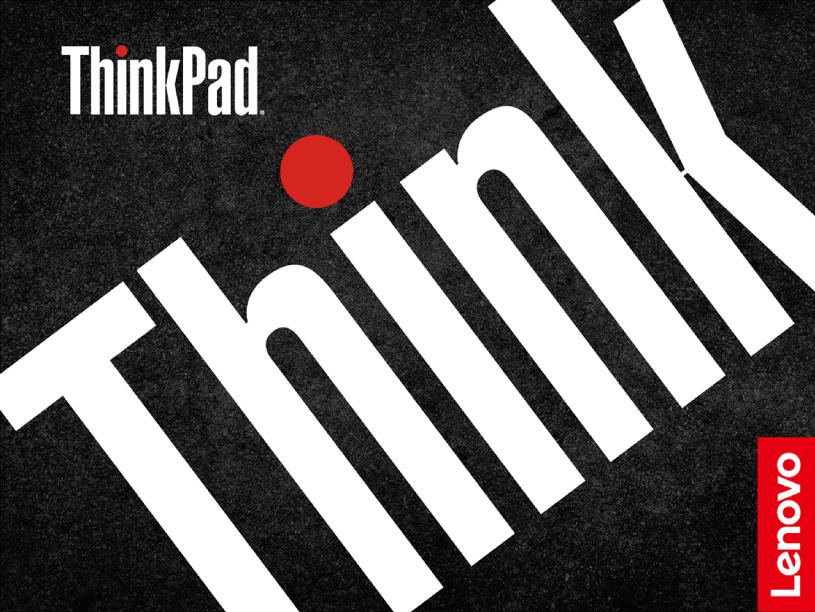
E14 Gen 2 and E15 Gen 2
User Guide
Read this first
Before using this documentation and the product it supports, ensure that you read and understand the following:
•Appendix A “Important safety information” on page 53
•Safety and Warranty Guide
•Setup Guide
Second Edition (October 2020)
© Copyright Lenovo 2020.
LIMITED AND RESTRICTED RIGHTS NOTICE: If data or software is delivered pursuant to a General Services Administration “GSA” contract, use, reproduction, or disclosure is subject to restrictions set forth in Contract No. GS- 35F-05925.

Contents
About this documentation . . . . . . . .iii
Chapter 1. Meet your computer . . . . . 1
Front . . . . . . . . . . . . . . . . . . . . 1
Base . . . . . . . . . . . . . . . . . . . |
. |
3 |
Left . . . . . . . . . . . . . . . . . . . |
. |
5 |
Right . . . . . . . . . . . . . . . . . . . . 8 |
||
Features and specifications . . . . . . . . . . |
. |
9 |
Statement on USB transfer rate . . . . . . . |
|
10 |
Chapter 2. Get started with your computer . . . . . . . . . . . . . . . . 11
Get started with Windows 10 . . . . . . . . . |
11 |
Windows account . . . . . . . . . . . . |
11 |
Windows user interface . . . . . . . . . . |
12 |
Windows label . . . . . . . . . . . . . |
13 |
Connect to networks . . . . . . . . . . . . . |
13 |
Connect to the wired Ethernet . . . . . . . |
13 |
Connect to Wi-Fi networks. . . . . . . . . |
13 |
Use the Vantage app . . . . . . . . . . . . . |
14 |
Interact with your computer . . . . . . . . . . |
14 |
Use the keyboard shortcuts . . . . . . . . |
15 |
Use the TrackPoint pointing device . . . . . |
17 |
Use the trackpad . . . . . . . . . . . . |
18 |
Use the multi-touch screen . . . . . . . . |
20 |
Use the Intelligent Cooling feature . . . . . . |
22 |
Use multimedia . . . . . . . . . . . . . . . |
23 |
Use audio . . . . . . . . . . . . . . . |
23 |
Connect to an external display . . . . . . . |
23 |
Use Night light mode. . . . . . . . . . . . . |
24 |
Chapter 3. Explore your computer . . |
25 |
Manage power . . . . . . . . . . . . . . . |
25 |
Check the battery status and temperature. . . 25 |
|
Charge the computer . . . . . . . . . . . |
25 |
Maximize the battery life . . . . . . . . . |
26 |
Set power button behaviors . . . . . . . . |
26 |
Set the power plan . . . . . . . . . . . . |
26 |
Transfer data . . . . . . . . . . . . . . . . |
26 |
Connect to a Bluetooth-enabled device. . . . |
27 |
Airplane mode . . . . . . . . . . . . . . . |
27 |
Purchase options . . . . . . . . . . . . . . |
27 |
Chapter 4. Secure your computer |
|
and information . . . . . . . . . . . . |
29 |
Lock the computer . . . . . . . . . . . . . |
29 |
Use passwords . . . . . . . . . . . . . . . |
29 |
Password types . . . . . . . . . . . . . |
29 |
Set, change, and remove a password . . . . |
31 |
Use Power Loss Protection function (for selected |
|
models) . . . . . . . . . . . . . . . . . . |
32 |
Use the fingerprint reader (for selected models) . . |
32 |
Use face authentication (for selected models) . . . |
32 |
Use firewalls and antivirus programs. . . . . . . |
33 |
Chapter 5. Configure advanced
settings. . . . . . . . . . . . . . . . . 35
UEFI BIOS . . . . . . . . . . . . . . . . . |
35 |
What is UEFI BIOS . . . . . . . . . . . . |
35 |
Enter the UEFI BIOS menu . . . . . . . . . |
35 |
Navigate in the UEFI BIOS interface . . . . . |
35 |
Change the startup sequence . . . . . . . |
35 |
Set the system date and time. . . . . . . . |
36 |
Update UEFI BIOS . . . . . . . . . . . . |
36 |
Recovery information . . . . . . . . . . . . |
36 |
Restore system files and settings to an earlier |
|
point . . . . . . . . . . . . . . . . . |
36 |
Restore your files from a backup . . . . . . |
36 |
Reset your computer . . . . . . . . . . . |
36 |
Use advanced options . . . . . . . . . . |
37 |
Windows automatic recovery. . . . . . . . |
37 |
Create and use a recovery USB device . . . . 37 |
|
Install Windows 10 and drivers . . . . . . . . . |
37 |
Chapter 6. CRU replacement . . . . . 39
What are CRUs . . . . . . . . . . . . . . . 39
Disable Fast Startup and the built-in battery. . . . 39
Replace a CRU . . . . . . . . . . . . . . . |
40 |
Base cover assembly . . . . . . . . . . . |
40 |
Memory module (for selected models) . . . . |
41 |
M.2 solid-state drive . . . . . . . . . . . |
43 |
Chapter 7. Help and support . . . . . |
47 |
Frequently asked questions . . . . . . . . . . |
47 |
Error messages . . . . . . . . . . . . . . . |
48 |
Beep errors . . . . . . . . . . . . . . . . |
49 |
Self-help resources . . . . . . . . . . . . . |
50 |
Call Lenovo . . . . . . . . . . . . . . . . |
50 |
Before you contact Lenovo . . . . . . . . |
50 |
Lenovo Customer Support Center . . . . . . |
51 |
Purchase additional services. . . . . . . . . . |
52 |
Appendix A. Important safety information . . . . . . . . . . . . . . . 53
© Copyright Lenovo 2020 |
i |
Appendix B. Accessibility and |
|
Appendix D. Notices and |
ergonomic information . . . . . . . . |
67 |
trademarks . . . . . . . . . . . . . . . 85 |
Appendix C. Compliance and TCO |
|
|
Certified information . . . . . . . . . . |
71 |
|
ii E14 Gen 2 and E15 Gen 2 User Guide

About this documentation
•Illustrations in this documentation might look different from your product.
•Depending on the model, some optional accessories, features, and software programs might not be available on your computer.
•Depending on the version of operating systems and programs, some user interface instructions might not be applicable to your computer.
•Documentation content is subject to change without notice. Lenovo makes constant improvements on the
documentation of your computer, including this User Guide To get the latest documentation, go to https:// |
. |
pcsupport.lenovo.com. |
|
•Microsoft® makes periodic feature changes to the Windows® operating system through Windows Update. As a result, some information in this documentation might become outdated. Refer to Microsoft resources for the latest information.
© Copyright Lenovo 2020 |
iii |
iv E14 Gen 2 and E15 Gen 2 User Guide
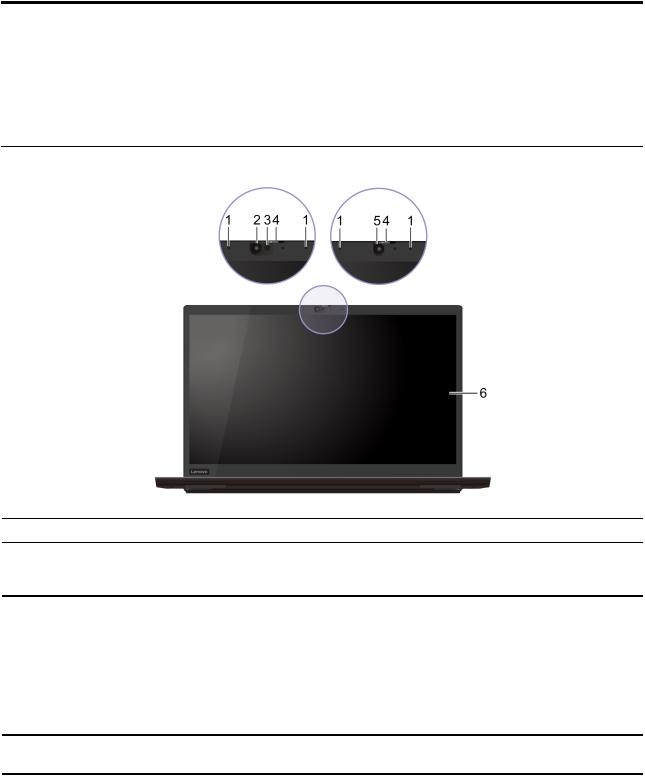
Chapter 1. Meet your computer
ThinkPad E14 Gen 2 and ThinkPad E15 Gen 2 might be shipped with different microprocessors, namely Intel® and Advanced Micro Devices (AMD). Hereby Intel models and AMD models are used to distinguish computer models with different microprocessors.
Front
1.Microphones
2.Infrared LED*
3.Camera with IR function*
4.ThinkShutter
Capture or record sound.
Emit infrared (IR) light.
Note: Do not block the IR light-emitting diode (LED). Otherwise, the IR function might not work.
Take pictures or record videos by clicking Camera from the Start menu. The indicator next to the camera is on when the camera is in use.
Log in to your computer with face authentication. See “Use face authentication (for selected models)” on page 32.
If you use other apps that support photographing, video chatting, and video conference, the camera starts automatically when you enable the camerarequired feature from the app.
Slide ThinkShutter to cover or uncover the camera lens. It is designed to protect your privacy.
© Copyright Lenovo 2020 |
1 |

5.Camera*
6.Multi-touch screen*
*for selected models
Take pictures or record videos by clicking Camera from the Start menu. The indicator next to the camera is on when the camera is in use.
If you use other apps that support photographing, video chatting, and video conference, the camera starts automatically when you enable the camerarequired feature from the app.
Enable you to use your computer with simple touch gestures. See “Use the multitouch screen” on page 20.
2 E14 Gen 2 and E15 Gen 2 User Guide
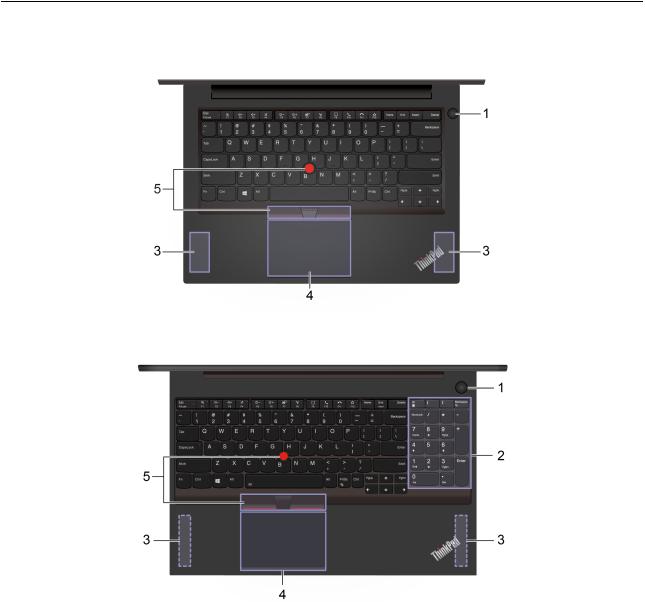
Base
E14 Gen 2
E15 Gen 2
Chapter 1. Meet your computer 3

1. Power button / Power button with fingerprint reader function*
2.Numeric keypad
3.Speakers
4.Trackpad
5.TrackPoint® pointing device
*for selected models
Use as power button
Press to turn on the computer or put the computer to sleep mode.
To turn off the computer, open the Start menu, click  Power and then select
Power and then select
Shut down .
The indicator in the power button shows the system status of your computer.
•White, Blinking for three times: The computer is initially connected to power.
•White, On: The computer is on.
•Off: The computer is off or in hibernation mode.
•White, Blinking rapidly: The computer is entering sleep or hibernation mode.
•White, Blinking slowly: The computer is in sleep mode.
Use as fingerprint reader
Log in to your computer with enrolled fingerprints. See “Use the fingerprint reader (for selected models)” on page 32.
The indicator shows the status of the fingerprint reader:
•Green, blinking for two seconds, then turn solid on: The computer is ready for fingerprint scan.
•White, solid on: The scan is successful.
Quickly input numbers.
Enable you to experience high-quality sound.
Perform finger touch and all the functions of a traditional mouse. See “Use the trackpad” on page 18.
Perform all the functions of a traditional mouse. See “Use the TrackPoint pointing device” on page 17.
4 E14 Gen 2 and E15 Gen 2 User Guide
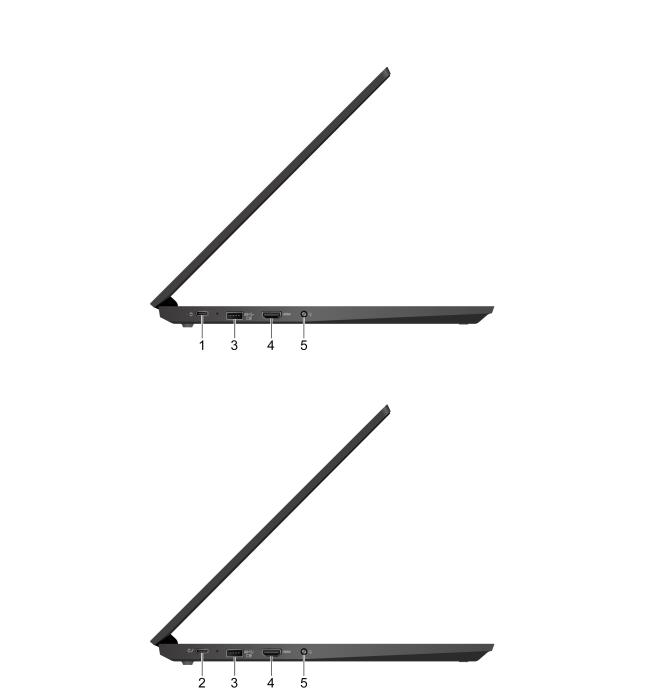
Left
For AMD models
For Intel models
Chapter 1. Meet your computer 5

1.USB-C® connector (USB 3.2 Gen 1)
2. Thunderbolt™ 4 connector (USB-C)
3. Always On USB 3.2 Gen 1 connector
•Charge your computer.
•Charge USB-C compatible devices with the output voltage and current of 5 V and 3 A.
•Transfer data at USB 3.2 speed, up to 5 Gbps.
•Connect to an external display:
–USB-C to VGA: 1920 x 1080 pixels, 60 Hz
–USB-C to DP: 3840 x 2160 pixels, 60 Hz
•Supply power to another computer using P-to-P (Peer to Peer) 2.0 charging function. See “Use P-to-P 2.0 charging function” on page 25.
•Connect to USB-C accessories to help expand your computer functionality. To purchase USB-C accessories, go to https://www.lenovo.com/accessories.
Note: When the battery power is below 10%, the connected USB-C accessories might not work correctly.
•Charge your computer.
•Charge USB-C compatible devices with the output voltage and current of 5 V and 3 A.
•Transfer data:
–Thunderbolt 4 speed, up to 40 Gbps (when the device connected is Thunderbolt 4 or Thunderbolt 3 compatible )
–USB 3.2 Gen 2 speed, up to 10 Gbps (when the device connected is not Thunderbolt 4 or Thunderbolt 3 compatible)
•Connect to an external display:
–USB-C to VGA: 1920 x 1200 pixels, 60 Hz
–USB-C to DP: 5120 x 3200 pixels, 60 Hz
•Connect to USB-C accessories to help expand your computer functionality. To purchase USB-C accessories, go to https://www.lenovo.com/accessories
•Supply power to another computer using P-to-P (Peer to Peer) 2.0 charging function. See “Charge the computer” on page 25.
Note: When the battery power is below 10%, the connected USB-C accessories might not work correctly.
With the Always On USB feature enabled, the Always On USB 3.2 Gen 1 connector can charge a USB-compatible device when the computer is on, off, in sleep mode, or in hibernation mode.
Notes:
•By default, Always On USB is enabled and Charge in Battery Mode is disabled in UEFI BIOS.
•When the computer is off or in hibernation mode, and Charge in Battery Mode is disabled in UEFI BIOS, ensure that you have connected the computer to ac power.
To enable the Always On USB feature:
1.Enter the UEFI BIOS menu. See “Enter the UEFI BIOS menu” on page 35.
2.Click Config USB Always On USB to enable the Always On USB feature.
6 E14 Gen 2 and E15 Gen 2 User Guide

4.HDMI connector
5.Audio connector
Connect to a compatible™ digital audio device or video monitor, such as an HDTV.
•Connect headphones with a 3.5-mm (0.14-inch) and 4-pole plug to listen to the sound from the computer.
•Connect a headset with a 3.5-mm (0.14-inch) and 4-pole plug to listen to the sound from the computer or talk with others.
Note: This connector does not support standalone external microphones.
Chapter 1. Meet your computer 7
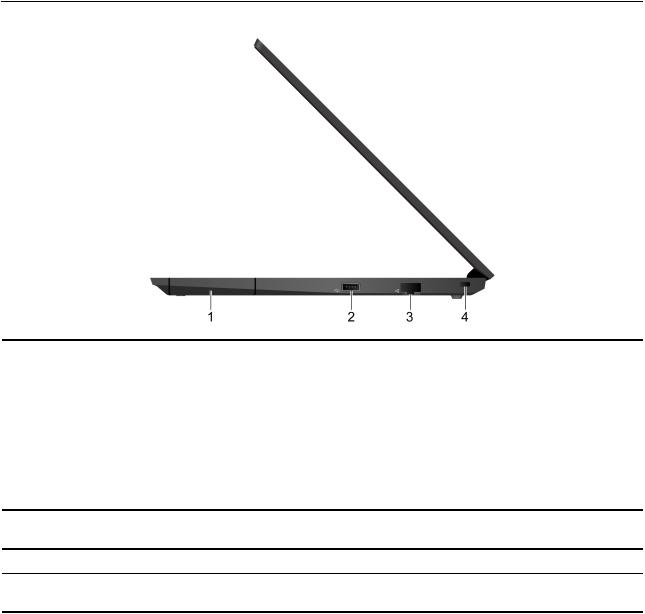
Right
1.ThinkPad Integrated Earbuds with Versa Bay (for E15 Gen 2 Intel model only)*
2.USB 2.0 connector
3.Ethernet connector
4.Security-lock slot
*for selected models
ThinkPad Integrated Earbuds are designed to support online meeting scenario.
ThinkPad Integrated Earbuds are the default audio device of your computer. Push the built-in earbud tray and then carefully pull the tray out of the slot.
To switch audio device, open Lenovo Bud'dy  from the Start menu. Lenovo Bud'dy enables you to know the earbuds status easily and customize earbuds settings.
from the Start menu. Lenovo Bud'dy enables you to know the earbuds status easily and customize earbuds settings.
To get the User Manual of ThinkPad Integrated Earbuds, go to https:// support.lenovo.com/docs/thinkpad_earbuds_manual.
Connect a USB-compatible device, such as a USB keyboard, USB mouse, USB storage device, or USB printer.
Connect to a local area network (LAN).
Lock your computer to a desk, table, or other fixtures through a compatible security cable lock. See “Lock the computer” on page 29.
8 E14 Gen 2 and E15 Gen 2 User Guide

Features and specifications
Dimensions
Maximum heat output
(depending on the model)
E14 Gen 2
•Width: 324 mm (12.76 inches)
•Depth: 220.7 mm (8.69 inches)
•Thickness: 18.65 mm to 21.05 mm (0.73 inches to 0.83 inches)
E15 Gen 2
•Width: 365 mm (14.37 inches)
•Depth: 240 mm (9.45 inches)
•Thickness: 18.9 mm to 19.65 mm (0.74 inches to 0.77 inches)
For AMD models:
•45 W (154 Btu/hr)
•65 W (222 Btu/hr)
For Intel models:
• 65 W (222 Btu/hr)
Power source (ac power adapter)
Microprocessor
Memory
Storage device
Display
Keyboard
•Sine-wave input at 50 Hz to 60 Hz
•Input rating of the ac power adapter: 100 V to 240 V ac, 50 Hz to 60 Hz
To view the microprocessor information of your computer, right-click the Start |
|
button and then click System |
. |
•Double data rate 4 (DDR4) small outline dual in-line memory module (SODIMM)*, up to 32 GB
•Double data rate 4 (DDR4) memory module soldered on the system board*, up to 8 GB
M.2 solid-state drive
•Brightness control
•Color display with Thin Film Transistor (TFT) technology*
•Color display with In-Plane Switching (IPS) or Twisted Nematic (TN) technology
•Display size:
–E14 Gen 2: 355.6 mm (14 inches)
–E15 Gen 2: 396.24 mm (15.6 inches)
•Display resolution: 1920 x 1080 pixels
•Integrated graphics
•Multi-touch technology*
•Function keys
•Numeric keypad (for E15 Gen 2 only)
•Six-row keyboard or six-row keyboard with backlight
•Trackpad
•TrackPoint pointing device
Chapter 1. Meet your computer 9

Connectors and slots
Security features
Wireless features
Others
* for selected models
•Audio connector
•Ethernet connector
•Always On USB 3.2 connector Gen 1
•HDMI connector
•USB 2.0 connector
•USB-C connector (USB 3.2 Gen 1) (for AMD models only)
•Thunderbolt 4 connector (USB-C) (for Intel models only)
•Face authentication*
•Fingerprint reader*
•Password
•Security-lock slot
•Trusted Platform Module (TPM)
•Bluetooth
•Wireless LAN
•Camera*
•Microphones
Statement on USB transfer rate
Depending on many factors such as the processing capability of the host and peripheral devices, file attributes, and other factors related to system configuration and operating environments, the actual transfer rate using the various USB connectors on this device will vary and will be slower than the data rate listed below for each corresponding device.
USB device |
Data rate (Gbit/s) |
|
3.2 Gen 1 |
/ 3.1 Gen 1 |
5 |
3.2 Gen 2 |
/ 3.1 Gen 2 |
10 |
3.2 Gen 2 |
× 2 |
20 |
10 E14 Gen 2 and E15 Gen 2 User Guide

Chapter 2. Get started with your computer
Get started with Windows 10
Learn the basics of Windows 10 and start working with it right away. For more information about Windows 10, see the Windows help information.
Windows account
A user account is required to use the Windows operating system. It can either be a Windows user account or a Microsoft account.
Windows user account
When you start Windows for the first time, you are prompted to create a Windows user account. This first account you created is of the “Administrator” type. With an Administrator account, you can create additional user accounts or change account types by doing the following:
1.Open the Start menu and select Settings Accounts Family & other users
2.Follow the on-screen instructions.
Microsoft account
You can also log in to the Windows operating system with a Microsoft account.
To create a Microsoft account, go to the Microsoft sign-up page at https://signup.live.com and follow the onscreen instructions.
With a Microsoft account, you can:
•Enjoy one-time signing in if you are using other Microsoft services, such as OneDrive, Skype, and Outlook. com.
•Sync personalized settings across other Windows-based devices.
© Copyright Lenovo 2020 |
11 |

Windows user interface
1.Account 
2.Documents 
3.Pictures 
4.Settings 
5.Power 
6.Start button 
7.Windows Search 
8.Task View 
9.Windows notification area
10.Battery status icon
11.Network icon
12.Action center 
Open the Start menu
Change account settings, lock the computer, or sign out from the current account.
Open the Documents folder, a default folder to save your received files.
Open the Pictures folder, a default folder to save your received pictures.
Launch Settings.
Shut down, restart, or put the computer into sleep mode.
Open the Start menu.
Type what you are looking for in the search box and get search results from your computer and the Web.
Display all opened apps and switch among them.
Display notifications and status of some features.
Display power status and change battery or power settings. When your computer is not connected to ac power, the icon changes to  .
.
Connect to an available wireless network and display the network status. When connected to a wired network, the icon changes to  .
.
Display the latest notifications from apps and provide quick access to some features.
•Click the Start button.
•Press the Windows logo key on the keyboard.
Access Control Panel
• Open the Start menu and click Windows System Control Panel |
. |
12 E14 Gen 2 and E15 Gen 2 User Guide

• Use Windows Search.
Launch an app
•Open the Start menu and select the app you want to launch.
•Use Windows Search.
Windows label
Your computer might have a Windows 10 Genuine Microsoft label affixed to its cover depending on the following factors:
•Your geographic location
•Edition of Windows 10 that is preinstalled
Go to https://www.microsoft.com/en-us/howtotell/Hardware.aspx for illustrations of the various types of Genuine Microsoft labels.
•In the People’s Republic of China, the Genuine Microsoft label is required on all computer models preinstalled with any version of Windows 10.
•In other countries and regions, the Genuine Microsoft label is required only on computer models licensed for Windows 10 Pro.
The absence of a Genuine Microsoft label does not indicate that the preinstalled Windows version is not genuine. For details on how to tell whether your preinstalled Windows product is genuine, refer to the information provided by Microsoft at https://www.microsoft.com/en-us/howtotell/default.aspx.
There are no external, visual indicators of the Product ID or Windows version for which the computer is licensed. Instead, the Product ID is recorded in the computer firmware. Whenever a Windows 10 product is installed, the installation program checks the computer firmware for a valid, matching Product ID to complete the activation.
In some cases, an earlier Windows version might be preinstalled under the terms of the Windows 10 Pro license downgrade rights.
Connect to networks
Your computer helps you connect to the world through a wired or wireless network.
Connect to the wired Ethernet
Connect your computer to a local network through the Ethernet connector on your computer with an Ethernet cable.
Note: If the computer is connected to a supported docking station or dock, use the Ethernet connector on the docking station or dock instead of the one on the computer.
Connect to Wi-Fi networks
1.Click the network icon in the Windows notification area. A list of available wireless networks is displayed.
2.Select a network available for connection. Provide required information, if needed.
Chapter 2. Get started with your computer 13

Use the Vantage app
The preinstalled Vantage app is a customized one-stop solution to help you maintain your computer with automated updates and fixes, configure hardware settings, and get personalized support.
To access the Vantage app, type Vantage in the search box.
Key features
The Vantage app enables you to:
•Know the device status easily and customize device settings.
•Download and install UEFI BIOS, firmware, and driver updates to keep your computer up-to-date.
•Monitor your computer health, and secure your computer against outside threats.
•Scan your computer hardware and diagnose hardware problems.
•Look up warranty status (online).
•Access User Guide and helpful articles.
Notes:
•The available features vary depending on the computer model.
•The Vantage app makes periodic updates of the features to keep improving your experience with your computer. The description of features might be different from that on your actual user interface.
Interact with your computer
Your computer provides you various ways to navigate the screen.
14 E14 Gen 2 and E15 Gen 2 User Guide
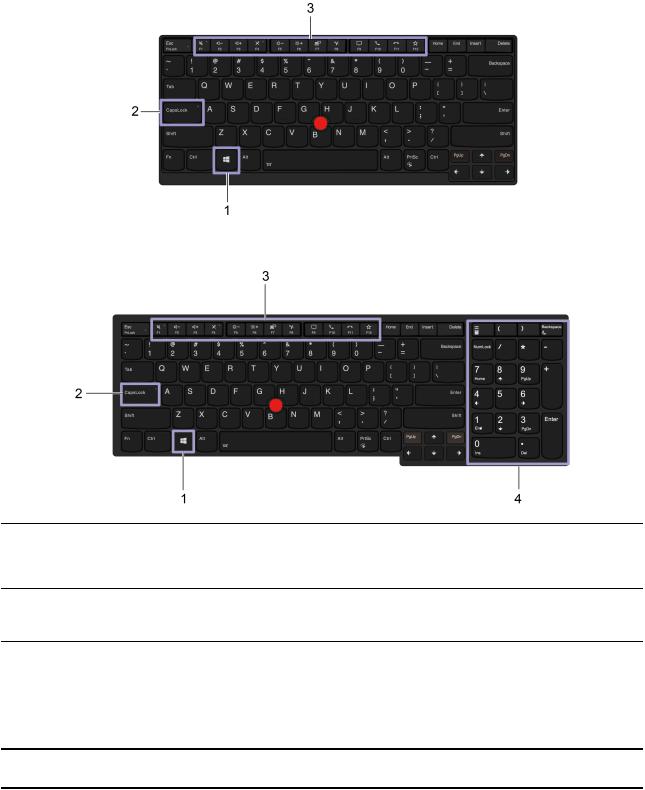
Use the keyboard shortcuts
The special keys on the keyboard help you work more easily and effectively.
E14 Gen 2
E15 Gen 2
1.Windows logo key
2.Caps Lock key
3.F1–F12 function keys
4.Numeric keypad (for E15 Gen 2 only)
Open the Start menu.
For information about using this key with other keys, see the Windows help information.
Switch the letter case between the upper case and lower case. When the key indicator is on, you can type uppercase letters.
Invoke the special function printed as an icon on each key or standard function. To choose whether to invoke the special function or standard function:
1.Go to Control Panel and view by Large icons or Small icons.
2.Click Keyboard or Lenovo - Keyboard Manager and select the option of your preference.
Input numbers quickly when the Numeric Lock indicator is on.
Chapter 2. Get started with your computer 15
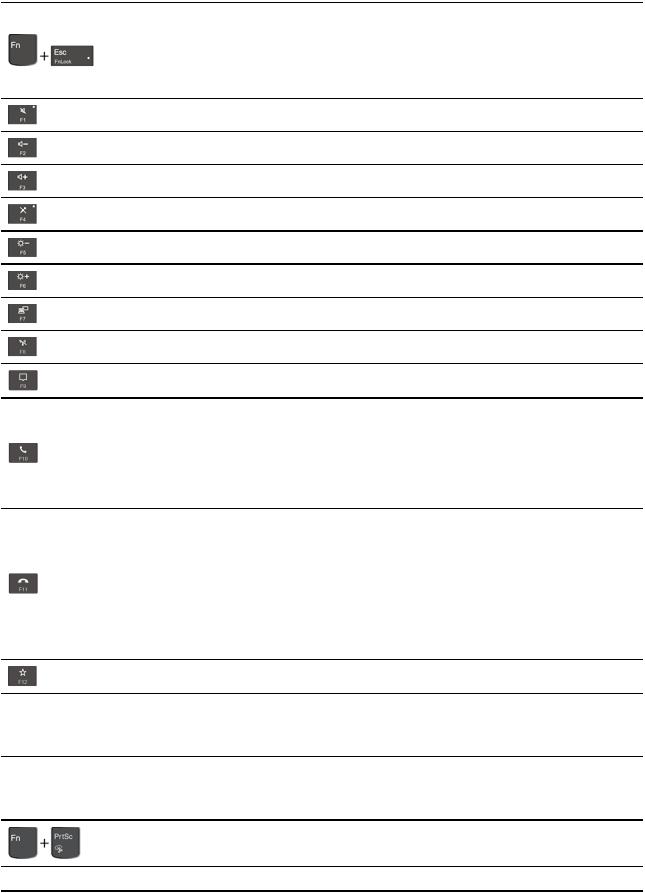
 (for E15 Gen 2
(for E15 Gen 2
only)
 (for E15 Gen 2
(for E15 Gen 2
only)
Fn+Spacebar
Invoke the special function printed as an icon on each key or standard function of F1–F12 function keys.
Fn Lock indicator on: standard function
Fn Lock indicator off: special function
Enable / disable speakers
Decrease volume
Increase volume
Enable / disable microphones
Darken display
Brighten display
Manage external displays
Enable / disable wireless
Open / collapse notification center
Answer incoming calls.
This function only works with some apps, such as Skype for Business 2016 and Microsoft Teams 1.0.
By default, the function works with Skype for Business 2016. You can change the default setting on Lenovo Vantage.
Decline incoming calls.
This function only works with some apps, such as Skype for Business 2016 and Microsoft Teams 1.0.
By default, the function works with Skype for Business 2016. You can change the default setting on Lenovo Vantage.
Note: You can also press F11 to hang up ongoing calls on Skype for Business 2016.
Customize the function of this key on Lenovo Vantage
Open the calculator
Enter sleep mode
Open Snipping Tool
Toggle keyboard backlight
16 E14 Gen 2 and E15 Gen 2 User Guide

Fn+B
Fn+K
Fn+P
Fn+S
Fn+4
Fn+Left arrow key Fn+Right arrow key
Break operation
Scroll contents
Pause operation
Send system request
Enter sleep mode
To wake up the computer, press Fn or the power button. Go to beginning
Go to end
Use the TrackPoint pointing device
The TrackPoint pointing device enables you to perform all the functions of a traditional mouse, such as pointing, clicking, and scrolling.
Use the TrackPoint pointing device
1. Pointing stick
Use your index finger or middle finger to apply pressure to the pointing-stick nonslip cap in any direction parallel to the keyboard. The pointer on the screen moves accordingly but the pointing stick itself does not move. The higher the pressure applied, the faster the pointer moves.
2. Left-click button
Press to select or open an item.
3. Right-click button
Press to display a shortcut menu.
4. Middle button
Chapter 2. Get started with your computer 17

Press and hold the dotted middle button while applying pressure to the pointing stick in the vertical or horizontal direction. Then, you can scroll through the document, Web site, or apps.
Disable the TrackPoint pointing device
The TrackPoint pointing device is active by default. To disable the device:
1.Open the Start menu, and then click Settings Devices Mouse
2.Follow the on-screen instructions to disable TrackPoint.
Replace the pointing-stick nonslip cap
Note: Ensure that the new cap has grooves a .
Use the trackpad
The entire trackpad surface is sensitive to finger touch and movement. You can use the trackpad to perform all the pointing, clicking, and scrolling functions of a traditional mouse.
Use the trackpad
1. Left-click zone
Press to select or open an item.
You also can tap anywhere on the surface of the trackpad with one finger to perform the left-click action.
18 E14 Gen 2 and E15 Gen 2 User Guide

2. Right-click zone
Press to display a shortcut menu.
You also can tap anywhere on the surface of the trackpad with two fingers to perform the right-click action.
Use the touch gestures
Tap
Tap anywhere on the trackpad with one finger to select or open an item.
Two-finger tap
Tap anywhere on the trackpad with two fingers to display a shortcut menu.
Two-finger scroll
Put two fingers on the trackpad and move them in the vertical or horizontal direction. This action enables you to scroll through the document, Web site, or apps.
Two-finger zoom out
Put two fingers on the trackpad and move them closer together to zoom out.
Two-finger zoom in
Put two fingers on the trackpad and move them farther apart to zoom in.
Chapter 2. Get started with your computer 19

Swipe three fingers up
Put three fingers on the trackpad and move them up to open the task view to see all your open windows.
Swipe three fingers down
Put three fingers on the trackpad and move them down to show the desktop.
Notes:
•When using two or more fingers, ensure that you position your fingers slightly apart.
•Some gestures are not available if the last action was done from the TrackPoint pointing device.
•Some gestures are only available when you are using certain apps.
•If the trackpad surface is stained with oil, turn off the computer first. Then, gently wipe the trackpad surface with a soft and lint-free cloth moistened with lukewarm water or computer cleaner.
For more gestures, see the help information of the pointing device.
Disable the trackpad
The trackpad is active by default. To disable the device:
1.Open the Start menu, and then click Settings Devices Touchpad
2.In the Touchpad section, turn off the Touchpad control.
Use the multi-touch screen
If your computer display supports the multi-touch function, you can navigate the screen with simple touch gestures.
Note: Some gestures might not be available depending on the app you use.
Tap once
•From the Start menu: Open an app or item.
•From the desktop: Select an app or item.
•In an open app: Perform an action such as Copy Save and
Delete depending on the app. |
, |
Tap twice quickly
Open an app or item from the desktop.
20 E14 Gen 2 and E15 Gen 2 User Guide

Tap and hold
Open a shortcut menu.
Slide
Scroll through items, such as lists, pages, and photos.
Drag an item to the location you want
Move an object.
Move two fingers closer together
Zoom out.
Move two fingers farther apart
Zoom in.
Swipe in from the right edge
Open the action center to see your notifications and quick actions.
Chapter 2. Get started with your computer 21
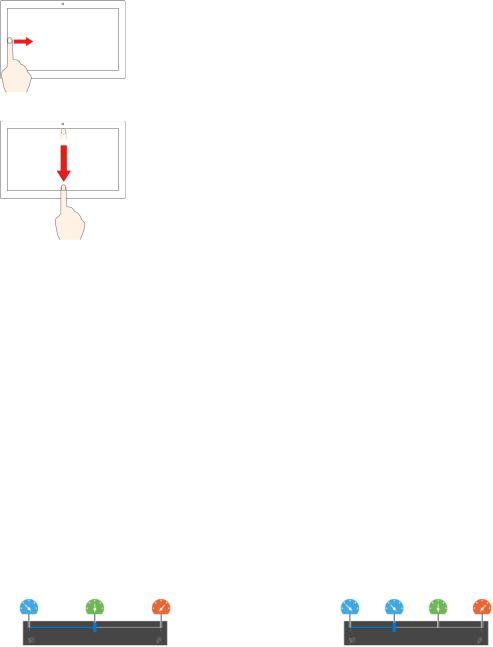
Swipe in from the left edge
View all your open windows in task view.
•Swipe downwards shortly from the top edge (for full-screened app or when your computer is in the tablet mode)
Show a hidden title bar.
•Swipe in from the top edge to the bottom edge (when your computer is in the tablet mode)
Close the current app.
Tips
•Turn off the computer before cleaning the multi-touch screen.
•Use a dry, soft, and lint-free cloth or a piece of absorbent cotton to remove fingerprints or dust from the multi-touch screen. Do not apply solvents to the cloth.
•The multi-touch screen is a glass panel covered with a plastic film. Do not apply pressure or place any metallic object on the screen, which might damage the touch panel or cause it to malfunction.
•Do not use fingernails, gloved fingers, or inanimate objects for input on the screen.
•Regularly calibrate the accuracy of the finger input to avoid a discrepancy.
Use the Intelligent Cooling feature
The Intelligent Cooling feature enables your computer to work in the following three modes:
•Quiet mode  : the quietest fan noise
: the quietest fan noise
•Balanced mode  : balanced performance and fan noise
: balanced performance and fan noise
•Performance mode  : the highest performance and normal fan noise
: the highest performance and normal fan noise
on ac power |
on battery power |
For computers with Windows operating system, do the following to select the preferred mode:
1.Click the battery status icon in the Windows notification area.
2.Move the slider to the left or right to select your preferred mode.
For computers with Linux operating system, the computer starts up in balanced mode by default. Do the following to switch to the preferred mode:
•Press Fn+L to switch to quiet mode.
•Press Fn+M to switch to balanced mode.
22 E14 Gen 2 and E15 Gen 2 User Guide

• Press Fn+H to switch to performance mode.
Use multimedia
Use your computer for business or entertainment with the built-in components (camera, speakers, and audio features) or connected external devices (an external projector, monitor, and HDTV).
Use audio
To enhance your audio experience, connect speakers, headphones, or a headset with a 3.5-mm (0.14-inch), 4-pole plug to the audio connector.
Change the sound settings
1. Go to Control Panel and view by category.
2. Click Hardware and Sound Sound |
. |
3. Change the settings as you prefer.
Connect to an external display
Connect your computer to a projector or a monitor to give presentations or expand your workspace.
Connect to a wired display
1.Connect the external display to an appropriate video connector on your computer, such as an HDMI connector, an USB-C connector or a Thunderbolt 4 connector(for Intel models only).
2.Connect the external display to an electrical outlet.
3.Turn on the external display.
If your computer cannot detect the external display, right-click a blank area on the desktop, and then click
Display settings Detect .
Supported resolution
The following table lists the supported maximum resolution of the external display.
Connect the external display to
the USB-C connector
the Thunderbolt 4 connector
the HDMI connector
Connect to a wireless display
Supported resolution
Up to 4096 x 2160 pixels / 60 Hz Up to 5120 x 3200 pixels / 60 Hz Up to 4096 x 2160 pixels / 30 Hz
To use a wireless display, ensure that both your computer and the external display support the Miracast® feature.
•Open the Start menu, and then click Settings Devices Bluetooth & other devices Add Bluetooth or other device In the Add a device window, click Wireless display or dock Then,. follow the instructions on the screen.
•Click the action center icon  in the Windows notification area and click Connect Select the wireless display and follow the on-screen instructions.
in the Windows notification area and click Connect Select the wireless display and follow the on-screen instructions.
Chapter 2. Get started with your computer 23
